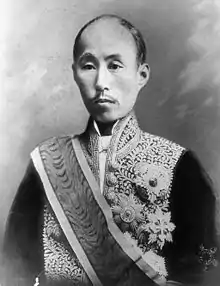Sanjō Sanetomi
Prince Sanjō Sanetomi (三条 実美, 13 March 1837 – 18 February 1891) was a Japanese Imperial court noble and statesman at the time of the Meiji Restoration. He held many high-ranking offices in the Meiji government.
Sanjō Sanetomi | |||||
|---|---|---|---|---|---|
| 三条 実美 | |||||
 Prince Sanetomi Sanjo,c. late 1880s | |||||
| Lord Keeper of the Privy Seal | |||||
| In office 22 December 1885 – 18 February 1891 | |||||
| Monarch | Meiji | ||||
| Preceded by | Position established | ||||
| Succeeded by | Tokudaiji Sanetsune | ||||
| Acting Prime Minister of Japan | |||||
| In office 25 October 1889 – 24 December 1889 | |||||
| Monarch | Meiji | ||||
| Preceded by | Kuroda Kiyotaka | ||||
| Succeeded by | Yamagata Aritomo | ||||
| Chancellor of the Realm of Japan | |||||
| In office 13 September 1868 – 22 December 1885 | |||||
| Monarch | Meiji | ||||
| Preceded by | Tokugawa Ienari | ||||
| Succeeded by | Position abolished | ||||
| Personal details | |||||
| Born | 13 March 1837 Kyoto, Japan | ||||
| Died | 18 February 1891 (aged 53) Tokyo, Japan | ||||
| Political party | Independent | ||||
| Japanese name | |||||
| Kanji | 三条 実美 | ||||
| |||||
Biography
%252C_Meiji_era%252C_19th_century%252C_oil_on_canvas_-_Tokyo_National_Museum_-_DSC05560.JPG.webp)
Born in Kyoto, Sanjō was the son of Naidaijin Sanjō Sanetsumu. He held several important posts in Court and became a central figure in the anti-Western, anti-Tokugawa sonnō jōi ("Revere the Emperor, Expel the Barbarian") movement.
When the coup d'état of September 30, 1863, brought the more moderate Aizu and Satsuma factions into power, he fled to Chōshū. He returned to Kyoto after the resignation of shōgun Tokugawa Yoshinobu in 1867.
The first administrative offices (Sanshoku) of the Meiji government were established on January 3, 1868: the Sōsai (President), Gijō (Administration) and San'yo (Office of Councilors). These offices were abolished on June 11, 1868, with the establishment of the Dajō-kan (Grand Council of State). In the new Meiji government, Sanjō was head of the Gijo, Minister of the Right (右大臣) (June 11, 1868 – August 15, 1871), and Chancellor of the Realm (Dajō-daijin) (August 15, 1871 – December 22, 1885).
Sanjō was awarded Grand Cordon of the Supreme Order of the Chrysanthemum in 1882. On July 7, 1884, his title was changed to that of koshaku (prince) under the kazoku peerage system.
Sanjō served until the abolition of the dajōkan system in 1885. After the Cabinet system was established, he became Lord Keeper of the Privy Seal of Japan.
In 1889, when Prime Minister Kuroda Kiyotaka and his cabinet resigned en masse, Emperor Meiji only accepted Kuroda's resignation and formally invited Sanjō to head the government. The Emperor refused to appoint a new prime minister for the next two months, making Sanjō the only Prime Minister of Japan (albeit interim) who also concurrently held the post of Lord Keeper of the Privy Seal.[1]
In 1890, he assumed a seat in the new House of Peers in the Diet of Japan established by the Meiji Constitution. On his death in 1891, he was accorded a state funeral. His grave is at the temple of Gokoku-ji in Bunkyō, Tokyo.
Honours
From the corresponding article in the Japanese Wikipedia
- Grand Cordon of the Order of the Rising Sun (29 December 1876)
- Grand Cordon of the Order of the Chrysanthemum (11 April 1882)
- Prince (7 July 1884)
Order of precedence
- Junior fifth rank (31 January 1850)
- Fifth rank (4 July 1854)
- Fourth rank (22 May 1855)
- Senior fourth rank (29 January 1856)
- Third rank (6 November 1862; degraded 1863, restored 2 January 1868)
- First rank (12 June 1868)
- Senior first rank (18 February 1891)
Ancestry
| Ancestors of Sanjō Sanetomi | |||||||||||||||||||||||||||||||||||||||||||||||||||||||||||||||||||||||||||||||||||||||||||||||||||||||||||||||||||||||||||||||||||||||||||||||||||||||||||||||||||||||||||||||||||||||||||||||||||||||||||||||||||||||||||||||||||||||||||||||||||||||||||||||||||||||||||||||||||||||||||||||||||||||||||||||||||||||||||||||||||||||||||||||||||||||||||||||||||||||||||||||||||||||||||||||||||||||||||||||||||||||||||||||||||||||||||||||||||||||||||||||||||||||||||||||||||||||||||||||||||||||||||||||||||||||||||||||||||||||||||||||||||||||||||||
|---|---|---|---|---|---|---|---|---|---|---|---|---|---|---|---|---|---|---|---|---|---|---|---|---|---|---|---|---|---|---|---|---|---|---|---|---|---|---|---|---|---|---|---|---|---|---|---|---|---|---|---|---|---|---|---|---|---|---|---|---|---|---|---|---|---|---|---|---|---|---|---|---|---|---|---|---|---|---|---|---|---|---|---|---|---|---|---|---|---|---|---|---|---|---|---|---|---|---|---|---|---|---|---|---|---|---|---|---|---|---|---|---|---|---|---|---|---|---|---|---|---|---|---|---|---|---|---|---|---|---|---|---|---|---|---|---|---|---|---|---|---|---|---|---|---|---|---|---|---|---|---|---|---|---|---|---|---|---|---|---|---|---|---|---|---|---|---|---|---|---|---|---|---|---|---|---|---|---|---|---|---|---|---|---|---|---|---|---|---|---|---|---|---|---|---|---|---|---|---|---|---|---|---|---|---|---|---|---|---|---|---|---|---|---|---|---|---|---|---|---|---|---|---|---|---|---|---|---|---|---|---|---|---|---|---|---|---|---|---|---|---|---|---|---|---|---|---|---|---|---|---|---|---|---|---|---|---|---|---|---|---|---|---|---|---|---|---|---|---|---|---|---|---|---|---|---|---|---|---|---|---|---|---|---|---|---|---|---|---|---|---|---|---|---|---|---|---|---|---|---|---|---|---|---|---|---|---|---|---|---|---|---|---|---|---|---|---|---|---|---|---|---|---|---|---|---|---|---|---|---|---|---|---|---|---|---|---|---|---|---|---|---|---|---|---|---|---|---|---|---|---|---|---|---|---|---|---|---|---|---|---|---|---|---|---|---|---|---|---|---|---|---|---|---|---|---|---|---|---|---|---|---|---|---|---|---|---|---|---|---|---|---|---|---|---|---|---|---|---|---|---|---|---|---|---|---|---|---|---|---|---|---|---|---|---|---|---|---|---|---|---|---|---|---|---|---|---|---|---|---|---|---|---|---|---|---|---|---|---|---|---|---|---|---|---|---|---|---|---|---|---|---|---|---|---|---|---|---|---|---|---|---|---|---|---|---|---|---|---|---|---|---|---|---|---|---|---|---|---|---|---|---|---|---|---|---|---|---|---|---|---|---|---|---|---|---|---|---|---|---|---|---|---|---|---|---|---|---|---|---|---|---|---|---|---|---|---|---|---|---|---|---|---|---|---|---|---|---|---|---|---|---|---|---|---|---|---|---|---|---|---|
| |||||||||||||||||||||||||||||||||||||||||||||||||||||||||||||||||||||||||||||||||||||||||||||||||||||||||||||||||||||||||||||||||||||||||||||||||||||||||||||||||||||||||||||||||||||||||||||||||||||||||||||||||||||||||||||||||||||||||||||||||||||||||||||||||||||||||||||||||||||||||||||||||||||||||||||||||||||||||||||||||||||||||||||||||||||||||||||||||||||||||||||||||||||||||||||||||||||||||||||||||||||||||||||||||||||||||||||||||||||||||||||||||||||||||||||||||||||||||||||||||||||||||||||||||||||||||||||||||||||||||||||||||||||||||||||
Notes
- After the Meiji Constitution was adopted in 1890, a new system was established: "In case of death, incapacitation, resignation or removal of the prime minister, a member of the cabinet shall serve as acting prime minister until the next prime minister is formally appointed." Today Sanjō’s government is generally regarded as continuation of Kuroda’s.
- "Sanjō genealogy". Reichsarchiv (in Japanese). 8 May 2010. Retrieved 14 October 2017.
References
- Beasley, William G. (1972). The Meiji Restoration. Stanford: Stanford University Press. ISBN 9780804708159; OCLC 579232
- Jansen, Marius B. and Gilbert Rozman, eds. (1986). Japan in Transition: from Tokugawa to Meiji. Princeton: Princeton University Press. ISBN 9780691054599; OCLC 12311985
- Keene, Donald. (2002). Emperor of Japan: Meiji and His World, 1852–1912. New York: Columbia University Press. ISBN 978-0-231-12340-2; OCLC 46731178
- Ozaki, Yukio. (2001). The Autobiography of Ozaki Yukio: The Struggle for Constitutional Government in Japan. [Translated by Fujiko Hara]. Princeton: Princeton University Press. ISBN 9780691050959; OCLC 45363447
External links
- National Diet Library biography and photo
- Meiji Dignitaries is a portrait of Sanetomi and others from 1877
- . Encyclopædia Britannica (11th ed.). 1911.